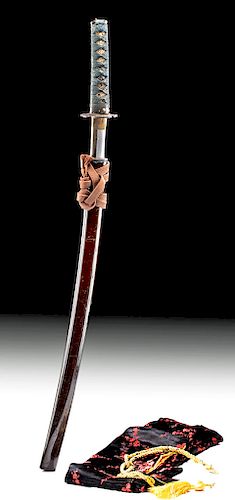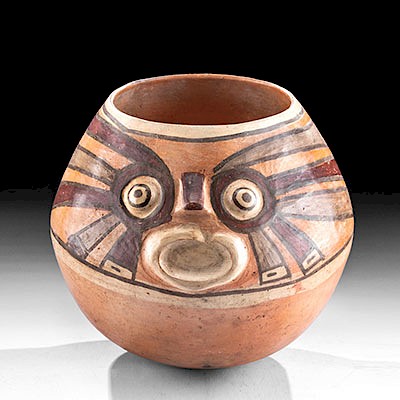Japanese Edo Steel Wakizashi w/ Lacquered Wood Sheath
Lot 82a
About Seller
Artemis Gallery
686 S Taylor Ave, Ste 106
Louisville, CO 80027
United States
Selling antiquities, ancient and ethnographic art online since 1993, Artemis Gallery specializes in Classical Antiquities (Egyptian, Greek, Roman, Near Eastern), Asian, Pre-Columbian, African / Tribal / Oceanographic art. Our extensive inventory includes pottery, stone, metal, wood, glass and textil...Read more
Categories
Estimate:
$2,500 - $3,500
Absentee vs Live bid
Two ways to bid:
- Leave a max absentee bid and the platform will bid on your behalf up to your maximum bid during the live auction.
- Bid live during the auction and your bids will be submitted real-time to the auctioneer.
Bid Increments
| Price | Bid Increment |
|---|---|
| $0 | $25 |
| $300 | $50 |
| $1,000 | $100 |
| $2,000 | $250 |
| $5,000 | $500 |
| $10,000 | $1,000 |
| $20,000 | $2,500 |
| $50,000 | $5,000 |
| $100,000 | $10,000 |
| $200,000 | $20,000 |
About Auction
By Artemis Gallery
Dec 5, 2019
Set Reminder
2019-12-05 10:00:00
2019-12-05 10:00:00
America/New_York
Bidsquare
Bidsquare : Ancient / Ethnographic - Holiday Edition
https://www.bidsquare.com/auctions/artemis-gallery/ancient-ethnographic---holiday-edition-4710
What to give this holiday season? Ancient & Ethnographic Art of course! Our special Holiday auction features hundreds of unique finds from all over the world. Artemis Gallery info@artemisgallery.com
What to give this holiday season? Ancient & Ethnographic Art of course! Our special Holiday auction features hundreds of unique finds from all over the world. Artemis Gallery info@artemisgallery.com
- Lot Description
East Asia, Japan, Edo Period, ca. late 17th century CE. A beautiful wakizashi with a single-edged blade, a scabbard (saya) made of lacquered (urushi) wood with a wooden cap (kojiri), and a handle (tsuka) wrapped with stingray skin (same) and cotton straps (tsuka-ito) topped with a brass cap (kashira) with shakudo butterflies. Two ornaments (menuki) within the handle wrappings depict a mythological creature called a kirin. The lobed iron hand guard (mokko tsuba) rests between brass outer rings and a brass blade cap (seppa). The shinogi-zukuri steel blade has a higher ridge line than the shobu-zukuri design, a diamond-shaped (iori-mune) profile, and a lightly curved (chu-kissaki) tip. An uneven, wavy (doranba) temper pattern formed by the tight-grained hammer-folding process (itame-hada) runs the length of the blade. Size (w/ sheath): 22.125" L x 2.5" W x 29.2" H (56.2 cm x 6.4 cm x 74.2 cm)
This traditional Japanese sword was both a weapon and a symbol of authority and social status. The wakizashi paired with the longer katana sword marked the wearer as a samurai. The shorter sword was seen as an auxiliary weapon, also used for fighting in close quarters. Wakizashi could also be worn by non-samurai if worn alone, and members of the merchant class (chonin) wore them because of the frequency of encountering bandits when traveling between Japan's cities.
Over the centuries that katana and wakizashi were made, the process of their manufacture became heavily regulated. For example, in 1683, the Tokugawa Shogunate made laws concerning the maximum size of katana and wakizashi. Meanwhile, once a samurai took ownership of his new weapon, he had to wear it in a highly regulated manner. Wakizashi and katana in this period were not only deadly weapons but also signs of prestige. The craftsmanship of this piece is evident and reflects hundreds of hours of work.
Blade is unsigned but includes an NBTHK Hozon paper attributed as "Hachimanyama Kiyohira," submitted on June 29, 2007.
Provenance: private J. Jones collection, Boulder, Colorado, USA, acquired in August 2019; ex-private Sacramento, California, USA collection
All items legal to buy/sell under U.S. Statute covering cultural patrimony Code 2600, CHAPTER 14, and are guaranteed to be as described or your money back.
A Certificate of Authenticity will accompany all winning bids.
We ship worldwide and handle all shipping in-house for your convenience.
#150771Blade is from the Edo period, but scabbard and handle may be from a later period; exterior cotton strap on sheath is modern. Minor nicks and abrasions to blade, sheath, and handle, with a couple of fissures to stingray skin panels. Great patina to blade and handle.Condition
- Shipping Info
-
All shipping is handled in-house for your convenience. Your invoice from Artemis Gallery will include shipping calculation instructions. If in doubt, please inquire BEFORE bidding for estimated shipping costs for individual items.
-
- Buyer's Premium



 EUR
EUR CAD
CAD AUD
AUD GBP
GBP MXN
MXN HKD
HKD CNY
CNY MYR
MYR SEK
SEK SGD
SGD CHF
CHF THB
THB














